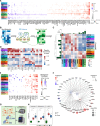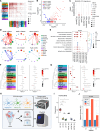This is a preprint.
Plasticity of Human Microglia and Brain Perivascular Macrophages in Aging and Alzheimer's Disease
- PMID: 39677435
- PMCID: PMC11643149
- DOI: 10.1101/2023.10.25.23297558
Plasticity of Human Microglia and Brain Perivascular Macrophages in Aging and Alzheimer's Disease
Abstract
The complex roles of myeloid cells, including microglia and perivascular macrophages, are central to the neurobiology of Alzheimer's disease (AD), yet they remain incompletely understood. Here, we profiled 832,505 human myeloid cells from the prefrontal cortex of 1,607 unique donors covering the human lifespan and varying degrees of AD neuropathology. We delineated 13 transcriptionally distinct myeloid subtypes organized into 6 subclasses and identified AD-associated adaptive changes in myeloid cells over aging and disease progression. The GPNMB subtype, linked to phagocytosis, increased significantly with AD burden and correlated with polygenic AD risk scores. By organizing AD-risk genes into a regulatory hierarchy, we identified and validated MITF as an upstream transcriptional activator of GPNMB, critical for maintaining phagocytosis. Through cell-to-cell interaction networks, we prioritized APOE-SORL1 and APOE-TREM2 ligand-receptor pairs, associated with AD progression. In both human and mouse models, TREM2 deficiency disrupted GPNMB expansion and reduced phagocytic function, suggesting that GPNMB's role in neuroprotection was TREM2-dependent. Our findings clarify myeloid subtypes implicated in aging and AD, advancing the mechanistic understanding of their role in AD and aiding therapeutic discovery.
Conflict of interest statement
Competing interests FJT consults for Immunai Inc., Singularity Bio B.V., CytoReason Ltd, Omniscope Ltd, Cellarity, and has ownership interests in Dermagnostix GmbH and Cellarity. The remaining authors declare no competing interests.
Figures




References
-
- Leng F., Edison P., Neuroinflammation and microglial activation in Alzheimer disease: where do we go from here? Nat. Rev. Neurol. 17, 157–172 (2021). - PubMed
-
- De Schepper S., Ge J. Z., Crowley G., Ferreira L. S. S., Garceau D., Toomey C. E., Sokolova D., Rueda-Carrasco J., Shin S.-H., Kim J.-S., Childs T., Lashley T., Burden J. J., Sasner M., Sala Frigerio C., Jung S., Hong S., Perivascular cells induce microglial phagocytic states and synaptic engulfment via SPP1 in mouse models of Alzheimer’s disease. Nat. Neurosci. 26, 406–415 (2023). - PMC - PubMed
-
- Keren-Shaul H., Spinrad A., Weiner A., Matcovitch-Natan O., Dvir-Szternfeld R., Ulland T. K., David E., Baruch K., Lara-Astaiso D., Toth B., Itzkovitz S., Colonna M., Schwartz M., Amit I., A Unique Microglia Type Associated with Restricting Development of Alzheimer’s Disease. Cell 169, 1276–1290.e17 (2017). - PubMed
Publication types
Grants and funding
LinkOut - more resources
Full Text Sources
Miscellaneous
